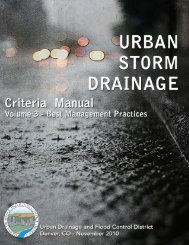DFHADprototype071409.. - Urban Drainage and Flood Control District
DFHADprototype071409.. - Urban Drainage and Flood Control District
DFHADprototype071409.. - Urban Drainage and Flood Control District
Create successful ePaper yourself
Turn your PDF publications into a flip-book with our unique Google optimized e-Paper software.
SECTION 2 – STUDY AREA<br />
2.1 PROJECT AREA<br />
The project area consis ts of the Hoff man <strong>Drainage</strong>way watershed which is located in the City of Thornton<br />
<strong>and</strong> portions of unincorporated Adam s County. The to tal watershed area is 1,161 acres or 1.81 square<br />
miles. The study area boundary is generally defined on the west by Grant Street, the north by East Thornton<br />
Parkway, the east by the Sout h Platte R iver, <strong>and</strong> th e south by Coronado Parkway. Early in the FHAD<br />
process, it was discovered that th e Hoffman <strong>Drainage</strong>way did not cont ain flood flows within its existing<br />
infrastructure which res ulted in m ultiple flood f low splits. Because of this, the watershed study area was<br />
exp<strong>and</strong>ed to consider additional storm runoff through the split flow areas.<br />
The Hoffman <strong>Drainage</strong>way starts near th e in tersection of Hoffm an Way <strong>and</strong> Dorothy Boulevard, runs<br />
southeast along Hoffman Way to 88 th Avenue, continues southeast throu gh a residential area to Devonshire<br />
Boulevard, then follows 86 th Avenue easterly to the South Platte River. The drainageway crosses 88<br />
Avenue, the Union Pacific Railroad (UPRR), the Colo rado Agricultural Ditch, a nd the Lower Clear Creek<br />
Canal (LCCC). See the Study Area map Figure 2-1.<br />
th<br />
HOFFMAN MAJOR DRAINAGEWAY PLANNING<br />
FLOOD HAZARD AREA DELINEATION<br />
L<strong>and</strong>-use information was obtained by sampling r<strong>and</strong>om areas of similar densities from the base mapping to<br />
calculate the imperviousness values. Additional discussions with the project sponsors were used to<br />
determine projected densities for the few areas that have yet to be developed. See Figure B-1 in Appendix<br />
B for the Imperviousness Map that illustrates the l<strong>and</strong>-use densities.<br />
There are two soil classifications within the project limits, types A <strong>and</strong> C <strong>and</strong> are described in Section 3.3.3.<br />
General watershed parameters include:<br />
Highest watershed elevation (approximate) = 5,446<br />
Lowest watershed elevation (approximate) = 5,070<br />
The average slope of the channel = 0.025 ft/ft<br />
Watershed shape (L/W) = 4<br />
A Project Reuse Watershed number for Hoffman <strong>Drainage</strong>way has not been defined.<br />
2.2 LAND USE<br />
The watershed is nearly built out, so only the fully-developed l<strong>and</strong>-use condition is considered for this<br />
study. The l<strong>and</strong>-use within the watershed can be broken down into the general l<strong>and</strong>-use categories which<br />
are summarized below. The watershed imperviousness is 60.2%.<br />
TABLE 2-1<br />
Fully-Developed L<strong>and</strong>-Use<br />
Imperviousness Area<br />
% (acres) (sq mi)<br />
30 50 0.08<br />
35 357 0.56<br />
45 36 0.06<br />
50 147 0.23<br />
55 39 0.06<br />
80 385 0.60<br />
90 72 0.11<br />
100 74 0.12<br />
2-1<br />
DFHAD Prototype
















